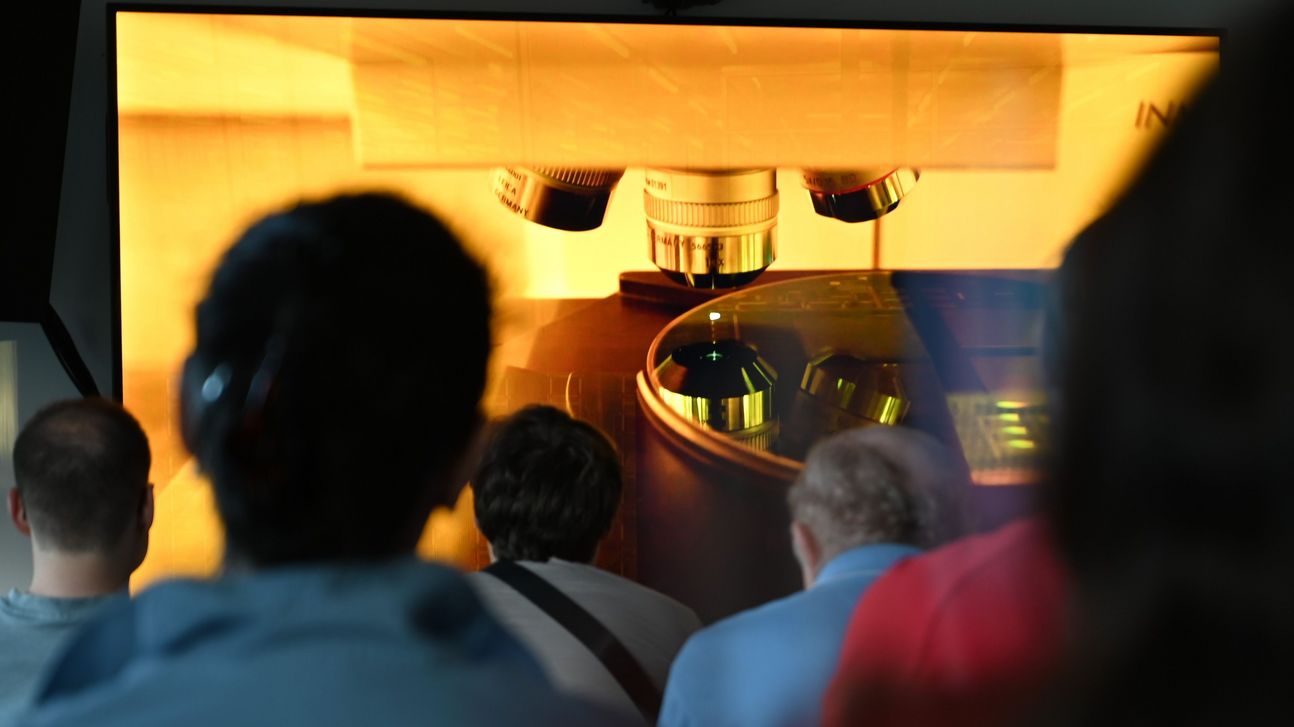“Semiconductors are found in all devices that we would describe as ‘smart’,” says Jelena Nincovic at the start of her introductory lecture at the Max Planck Semiconductor Laboratory. The laboratory is one of the world's leading research facilities in the field of semiconductor technology. Just last year, the new HLL building was opened on the Garching research campus, offering more than 1,500 square meters of state-of-the-art laboratory space. A single hair, a tiny speck of dust, the smallest fiber remnants: all these particles that surround us in a kind of cloud in everyday life would be a problem here in the production of high-precision semiconductors. In cleanrooms, the air is therefore filtered at great expense until it is almost completely free of unwanted particles – up to ten times cleaner than a sterile operating theater, depending on the cleanroom class. Less than 1,000 particles, invisible to the naked eye, are found in one cubic meter of air in the 600-square-meter cleanroom at the HLL, which has the third-highest cleanliness rating. This is ensured by a constant vertical airflow that feeds filtered air into the rooms from above and discharges it downward through perforated tables and floor panels. By comparison, one cubic meter of normal room air contains over 35 million particles. According to Jelena Nincovic, who has been head of the semiconductor laboratory for more than ten years, higher cleanliness classes can only be achieved in fully automated laboratories, such as those used in some areas of industry. Humans are no longer allowed to enter these laboratories; instead, they control all processes from outside.
At the HLL, where the most precise semiconductor technologies are developed in up to 500 coordinated process steps, such automation would not be worthwhile—the projects are too diverse for a robot to take over the tasks in the laboratory. For the scientists at HLL, this means spending time every day getting dressed for the cleanroom. Starting with special undergarments, protective clothing with overshoes, gloves, and masks, and finishing with safety goggles that cover the only part of the body that remains exposed—the eyes. The researchers enter the clean room via an airlock, where the last particles are removed under an air shower. Special paper is used for notes, which, unlike conventional paper, does not release tiny paper particles into the clean air. The movements of the scientists in the clean room are also designed to ensure that no particles are released: they always move as slowly as possible so as not to create air turbulence.
After the detailed explanation of the design and use of cleanrooms, visitors are left with one more question: Why are cleanrooms usually yellow? Jelena Nincovic explains that this has to do with photolithography, a process in which structures are applied to silicon wafers using UV radiation. The yellow light and yellow film on all windows prevent UV radiation from accidentally and uncontrollably exposing the materials. Controlling all parameters is extremely important for the production of high-tech semiconductor detectors, which are used in scientific experiments. The HLL's sensors are used in a wide range of applications. For example, one of the HLL's spectrometers is currently searching for life on Mars. An X-ray telescope on a satellite mapped the entire universe in X-rays and discovered new black holes. HLL sensors are also being used on Earth to discover new physics, for example in the ATLAS experiment at CERN. The HLL also plays a central role in Munich Quantum Valley. In collaboration with the Technical University of Munich and the Walther Meissner Institute, both located within sight on the research campus, superconducting qubits of the highest quality will be developed in the new premises as key components for future quantum computers.
Following the presentation, during which many questions were asked, visitors were given a glimpse into the clean rooms. Since the introduction made everyone aware of the effort involved in entering clean rooms, no one was surprised that the laboratories could only be visited virtually. The videos filmed with a drone easily conveyed the impression of what it is like to stand in the middle of the yellowish-glowing laboratory and carry out experiments there. At the end of the tour, visitors were still able to admire real sensors manufactured by HLL and silicon wafers shimmering colorfully in the light at close range. The presentation of the exhibits was also received with great interest and accompanied by countless questions.
More information:
All other events in the “MQV-Einblicke” series, with links to registration, can be found here: https://www.munich-quantum-valley.de/quantum-2025/mqv-einblicke
An overview of all further events organized by MQV and its partners to mark the International Year of Quantum can be found here: https://www.munich-quantum-valley.de/quantum-2025
